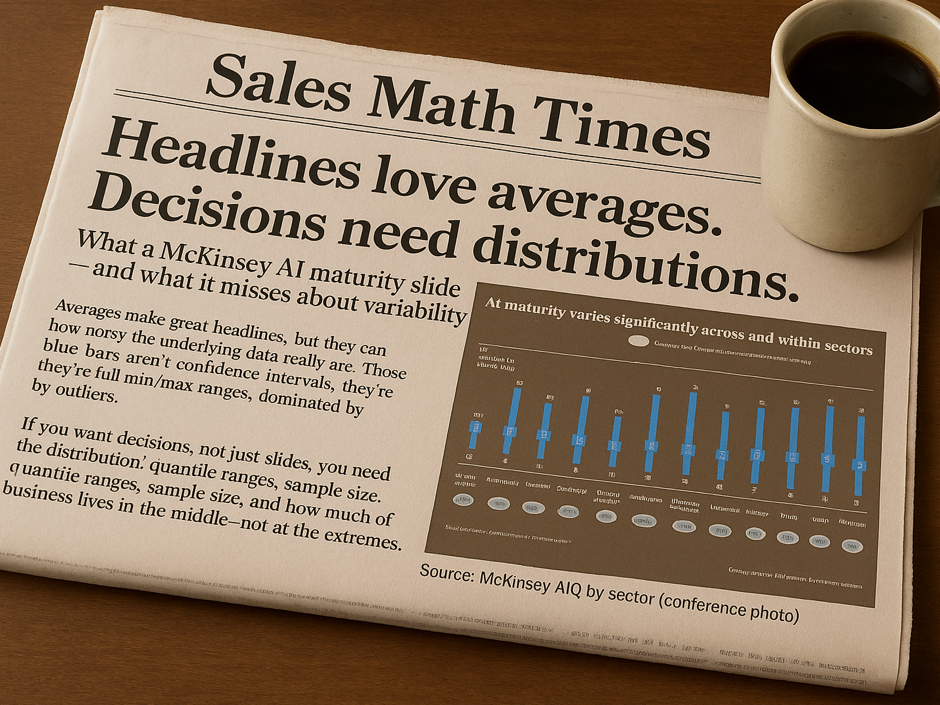How much should you spend on sales and marketing?
- Bill Kantor

- Jan 8, 2020
- 3 min read
Updated: Dec 4, 2024
Sixty four percent of gross profit. That’s not the answer, rather that’s the average of what we saw in our survey of public software companies.
We did this study because we believe that B2B sales and marketing is unnecessarily inefficient. And that machine learning can show you how to improve productivity. So we wanted to see how inefficient businesses really are.
As astonishingly high as that is, there are some notable outliers. Leading the pack and getting the award for spending the most—Domo came in at 288% of gross profit in 2017. And winning the award for spending the least… (drum roll) Open Text, coming in at just 19%. Those of you with “freemium business model envy” might look to Atlassian who spends a consistent 26%-28% of gross profit with an impressive 35-45% annual growth.
Here’s a chart showing sales and marketing spend (as a percent of gross profit) as a function of annual revenue.

Key drivers of increasing spend are:
Smaller business. There are economies of scale of course. That’s Oracle all the way over there on the right; SAP to the left of that (the blue cluster).
Where you are headquartered. Ok, we ran that analysis on a whim but there is no denying the difference. West coast HQ’d businesses spend almost twice as much as their counterparts elsewhere. What could they know that we don’t?
For those of you saying, “ahh… but those spending the most must be growing faster”, we've thought of that too. And we have a chart for that. (Here we have switched the Sales and Marketing Spend to the x-axis. So now the spend is the independent variable and CAGR is the dependent variable.)

Admittedly, there is a correlation between spending and higher growth. But the correlations are weak (see the R squared values) so we are not so sure about the wisdom of spending to fuel growth. At least not without other justifications, as there are plenty of companies spending less and getting good growth.
A couple of observations here worth noting. First, the distinction between west coast and everyone else is a lot smaller now. In fact, if you believe in a causal link between investing in sales and marketing and higher CAGR, the west coast folks are getting slightly less (admittedly insignificantly so) for their money. Second, all those trend lines do roughly converge at the same point on the left side. So, if you were to spend nothing on sales and marketing, this implies that you would only lose about 3% of sales (see the “intercept” or second figures for each of the linear fit lines).
Given how much you would be saving… this might be a serious discussion for some CEOs and boards. Just kidding... to make a point. To some extent B2B firms routinely do this on a limited scale. Ever noticed the annual "purge" of "low performing" salespeople? It the easiest way to increase productivity. Maybe there is a more effective way to increase productivity. We are suggesting that you can spend less and get more from your sales and marketing investment. It starts with insightful analytics that inform and help you optimize your hiring and lead generation efforts.
Ok so we are not advocating to cut marketing and sales spend to zero. But this does beg the question… what is the right spend? A rather disarming question. One that one of my smarter business school buddies asked when I showed her this analysis.
We don’t know. We think a lot about improving sales and marketing productivity by using machine learning to uncover exploitable bottlenecks and inefficiencies. So, the answer is you will have to figure out the right spend for yourself. But you can’t begin to answer that issue until you understand your constraints and inefficiencies. Can you answer these:
What should you expect from your existing operations?
What is holding you back?
Where do you have the most leverage from your resources?
This is where we find most business planning falls short. E.g., read our blog post Are bigger deals worth the extra effort. You may be surprised.
See how to sell more. Try Funnelcast. |




Comments